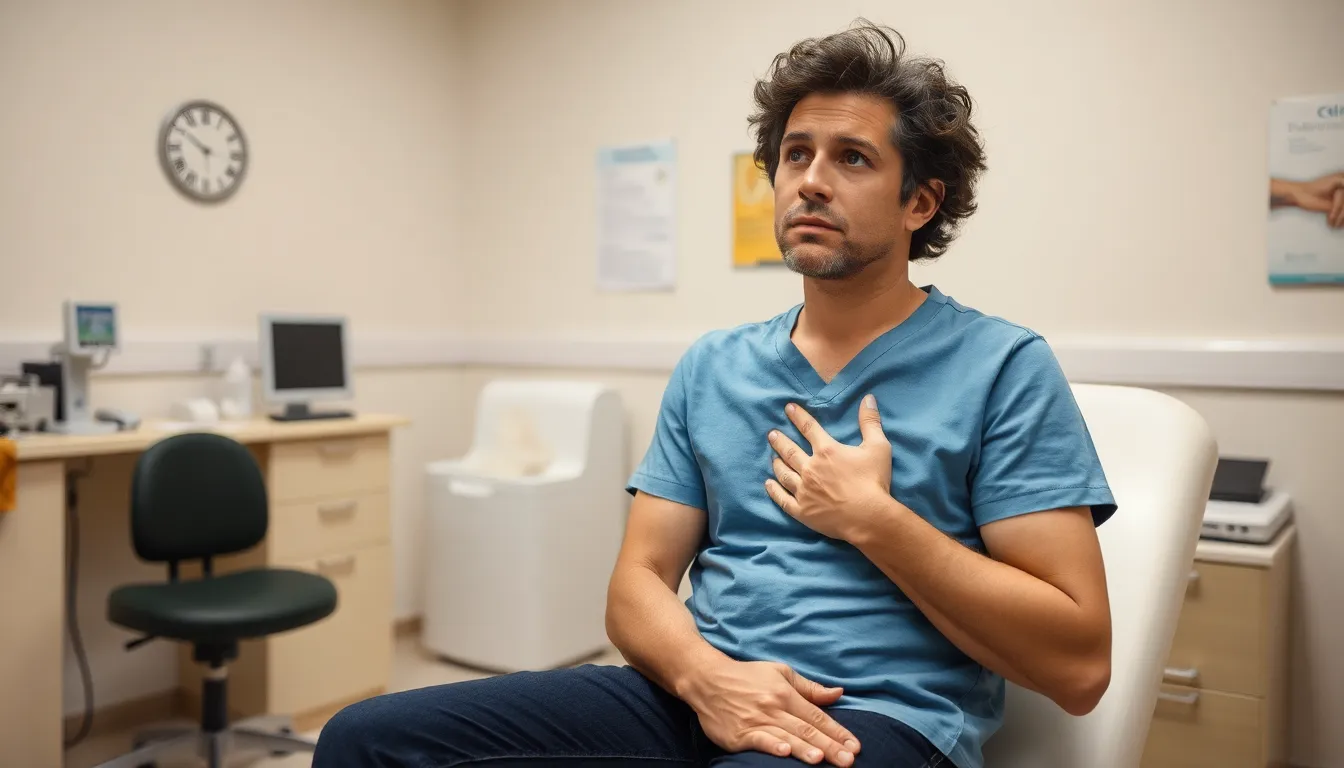Table of Contents
ToggleFeeling a twinge of pain under your left rib cage and back? You’re not alone. Many people experience this discomfort, and while it might feel like your body is staging a protest, it could be your cue to pay attention. From pesky gas bubbles to more serious issues, understanding the cause can help you find relief and maybe even a good laugh along the way.
Understanding Pain Under Left Rib Cage And Back
Pain under the left rib cage and back can stem from various conditions. It’s crucial to identify the specific cause for effective relief.
Common Causes
Gastrointestinal issues often lead to this type of pain. Conditions such as gas, acid reflux, or gastritis can cause discomfort in the left rib area. Musculoskeletal problems also play a role; strains, sprains, or rib injuries might create similar sensations. Kidney conditions could contribute as well. Kidney stones or infections often manifest in pain under the ribs and radiate to the back. Additionally, certain heart-related issues cannot be overlooked. While less common, cardiac problems may present as left-sided rib pain, necessitating prompt evaluation.
Symptoms to Watch For
Identifying symptoms associated with left rib cage pain is essential. Sharp or stabbing pain often suggests injury or inflammation. Aching or dull pain may indicate a gastrointestinal issue or muscle strain. Shortness of breath, along with pain, warrants immediate attention and could signal serious conditions. Nausea or vomiting accompanying rib pain often points to digestive concerns. Fever combined with rib pain may imply infection, such as a kidney issue. Monitoring these symptoms allows for timely consultation with a healthcare professional.
When to Seek Medical Attention

Experiencing persistent pain under the left rib cage and back warrants medical evaluation. Signs that indicate a need for immediate attention include severe or worsening pain. If sharp, stabbing pain occurs, especially after an injury, assessing injury-related issues becomes crucial.
Shortness of breath alongside rib pain signals potential emergencies. Conditions like pneumonia or cardiac events can manifest in this manner. Nausea, vomiting, or fever appearing with rib pain suggests possible infections or serious digestive concerns.
Seek help if pain radiates to other areas. Symptoms such as pain extending to the shoulder, jaw, or arm may indicate heart problems. Additional symptoms like swelling in the legs or abdomen call for urgent care.
Musculoskeletal discomfort can develop from significant trauma. If rib pain follows a fall or accident, a fracture or muscle strain might exist. Consulting a healthcare professional ensures appropriate diagnosis and treatment.
Finally, individuals with a history of kidney issues should act quickly when suffering from related pain. Kidney stones or infections could lead to more severe complications without prompt evaluation.
Recognizing these symptoms plays an essential role in managing health effectively. Acting swiftly can lead to better outcomes and alleviate concerns regarding serious medical conditions.
Diagnosis and Tests
Diagnosis of pain under the left rib cage and back often involves several tests to pinpoint its cause accurately.
Imaging Techniques
Imaging techniques like X-rays, CT scans, and ultrasounds help visualize internal structures. X-rays can reveal rib fractures or lung issues. A CT scan provides a detailed view of organs and tissues, assisting in identifying kidney stones or tumors. Ultrasounds excel in examining soft tissues and may detect fluid accumulation or organ abnormalities. These imaging modalities guide healthcare professionals in forming an accurate diagnosis.
Blood Tests
Blood tests play a crucial role in diagnosing underlying conditions. A complete blood count can reveal infections or inflammation. Liver function tests help assess any liver-related problems. Additionally, renal function tests evaluate kidney health, especially for individuals with associated symptoms. These tests offer valuable insights that aid in determining the appropriate treatment plan.
Treatment Options
Various treatment options exist for managing pain under the left rib cage and back. Options often depend on the underlying cause as well as individual circumstances.
Medications
Over-the-counter medications may provide initial relief. Nonsteroidal anti-inflammatory drugs (NSAIDs) such as ibuprofen effectively reduce inflammation and alleviate pain. Antacids treat gastrointestinal discomfort associated with issues like acid reflux, while prescription medications may be necessary for specific conditions. If a kidney issue is present, a doctor might prescribe opioids for severe pain management. Individuals should consult healthcare providers for personalized recommendations.
Physical Therapy
Physical therapy benefits many who experience pain under the left rib cage and back. Instructors may guide patients through exercises aimed at improving flexibility and strengthening abdominal and back muscles. Techniques like stretching and core stabilization often promote healing and prevent re-injury. Regular therapy sessions can provide progressive relief and help re-establish movement patterns. An evaluation from a physical therapist can determine the most beneficial approach tailored to individual needs.
Lifestyle Changes for Prevention
Maintaining a healthy lifestyle significantly reduces the risk of pain under the left rib cage and back. Incorporating a balanced diet enhances overall gastrointestinal health. Fruits, vegetables, whole grains, and lean proteins play a vital role in digestion and reduce acidity. Staying hydrated aids digestion and helps avoid kidney-related issues.
Regular exercise strengthens core and back muscles, promoting a robust musculoskeletal system. Activities such as walking, swimming, and yoga improve flexibility and relieve tension in the rib cage area. Practicing good posture also minimizes strain on the back, reducing the likelihood of developing pain.
Managing stress is essential for preventing discomfort. Incorporating relaxation techniques such as meditation and deep breathing exercises helps lower stress-related symptoms. Sleep quality directly impacts body recovery; ensuring adequate rest is crucial for overall health.
Avoiding smoking and limiting alcohol consumption contributes to better health outcomes. These substances can exacerbate gastrointestinal issues and stress the body. Taking breaks during prolonged sitting or standing prevents muscle stiffness and minimizes discomfort.
Seeking regular check-ups allows for early detection of potential problems. Monitoring symptoms and addressing them promptly can prevent conditions from worsening. Understanding one’s body and making necessary adjustments can lead to lasting improvements in well-being. Regular engagement in these preventative measures enhances quality of life while reducing the risk of recurrent pain.
Experiencing pain under the left rib cage and back can be unsettling. It’s essential to recognize the potential causes and associated symptoms to address the discomfort effectively. Understanding when to seek medical attention is crucial for ensuring proper care and preventing complications.
By adopting a healthy lifestyle and making necessary adjustments, individuals can improve their overall well-being and reduce the risk of recurrent pain. Regular check-ups and awareness of one’s body can lead to better health outcomes. Taking proactive steps toward health management not only alleviates discomfort but also promotes a more fulfilling life.










